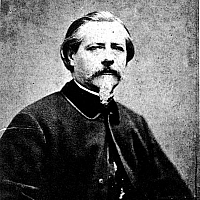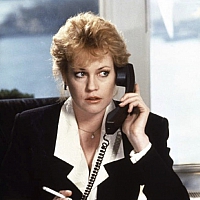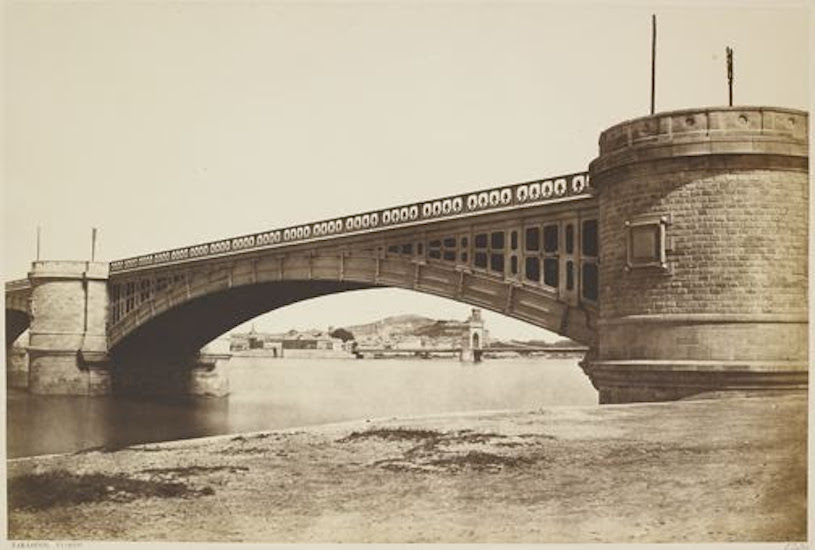
Édouard Baldus (French, 1813-1889), Tarascon. Viaduc, 1855 Albumen print from a glass negative 36.2 x 54.0 cm mounted on 45.5 x 60.8 cm paper
Expositions du 14/9/2015 au 20/11/2015 Terminé
Hans P. Kraus Jr. Fine Photographs 962 Park Avenue 10028 New York France
New York – Nineteenth-century photographs from the collection of Jay McDonald will be on view at Hans P. Kraus Jr. Fine Photographs in the first part of a two-part exhibition from June 30 through July 31, 2015. The exhibition presents architectural views by some of the early masters including Édouard Baldus, Charles Marville, Charles Nègre, Roger Fenton, Gustave Le Gray, and Captain Linnaeus Tripe, among others. The majority of the work on view was made during the 1850s. Part II of the exhibition focusing on early landscape photography from the MacDonald collection will be exhibited at the gallery September 14 through November 20.Hans P. Kraus Jr. Fine Photographs 962 Park Avenue 10028 New York France
“The pictures in this exhibition were taken in a period when photography was becoming popular, but before it had become a part of everyday life. This new art was still very special,” notes McDonald, a collector of 19th century and contemporary photography from Southern California. “For the first time viewers could see the military encampments in the Crimea, as well as a simple French farmhouse, or a bridge over a stream. Through translation into a photograph, wildly disparate objects attain a sort of equality, allowing us to gain similar pleasure and understanding from a photograph of a French farmyard as from one of the cathedral of Notre Dame.”
By 1855, Édouard Baldus (1813-1889) had become known as the leading architectural photographer in France and had begun documenting the building of the new Louvre museum. Among the photographs on view in the exhibition are his 1858 image Church of Saint-Pierre, Caen, a salt print made from a glass negative, which shows both his artistry and extraordinary attention to detail. Also included is a view of the viaduct in Tarascon, a stunning example of the scale and clarity that characterize Baldus’s photographs of French engineering and architectural monuments.
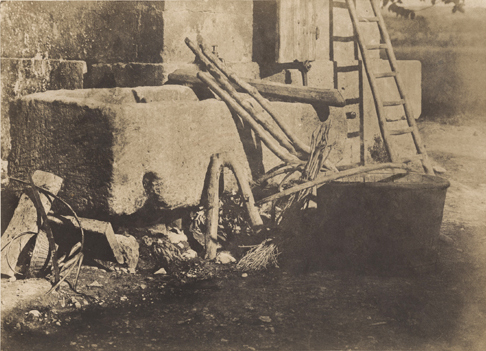
Paul Emile Mares, Farmyard with ladder, 1850s, coated salt print from a paper negative, 22.6 x 31.1 cm
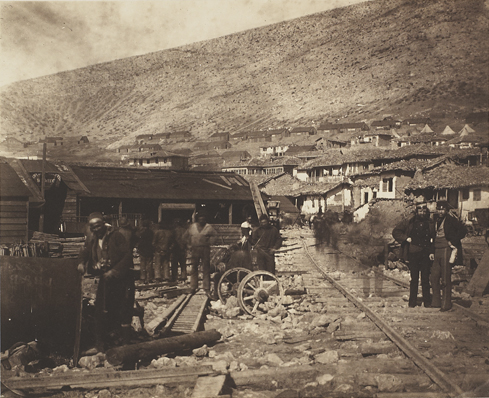
Roger Fenton, "The Railway Yard, Balaklava", 1855, salt print from a collodion negative, 20.4 x 25.1 cm
A central figure in French photography in the 1850s, Gustave Le Gray (1820-1884) wrote, “It is my deepest wish that photography, instead of falling within the domain of industry, of commerce, will be included among the arts.” He did much to further what became the new art including teaching many who would go on to become major figures in photography. His 1851 image of the church Saint-Pierre Loupiac in southwest France depicts the façade of the church. The negative for the image is in the collection of the Musée d’Orsay.
Charles Nègre (1820-1880) was a pupil of Le Gray, and a master of the paper negative. The exhibition features a striking photograph by Nègre of Notre-Dame de Paris, c. 1853, with a negative that is a very close variant. The cathedral is seen as a unified work of art, thanks to the unobstructed view of the entire façade. Nègre captured the cathedral’s towers as well as its portals – something his contemporaries had been unable to achieve.
Roger Fenton (British, 1819-1869) photographed the Crimean War in 1855, the first extensive photographic documentation of war. Over 350 glass negatives captured officers from the allied British, French and Turkish armies, harbor views, barren landscapes and camp scenes. The Railway Yard, Balaklava captures the activity at this warfront city.
The exhibition also includes striking rural views, two by lesser-known photographers that provide clues to daily life in the 1850s. Paul Emile Mares’s (1826-1900) Farmyard with ladder (France) is a coated salt print from a paper negative, and Henry White’s (1819-1903) Sled’s cottage (Wales) is an albumen print from a collodion negative. Both picturesque scenes vividly capture the detail, texture and character of their farm settings and exemplify Jay McDonald’s comment on the democratic nature of early 19th century photography. As much skill and observation was applied to portraying the ordinary environment as it was to capturing the monumental.
19th Century Architectural Views from the Collection of Jay McDonald will be exhibited from June 30 through July 31, 2015, at Hans P. Kraus Jr. Fine Photographs in New York City.




